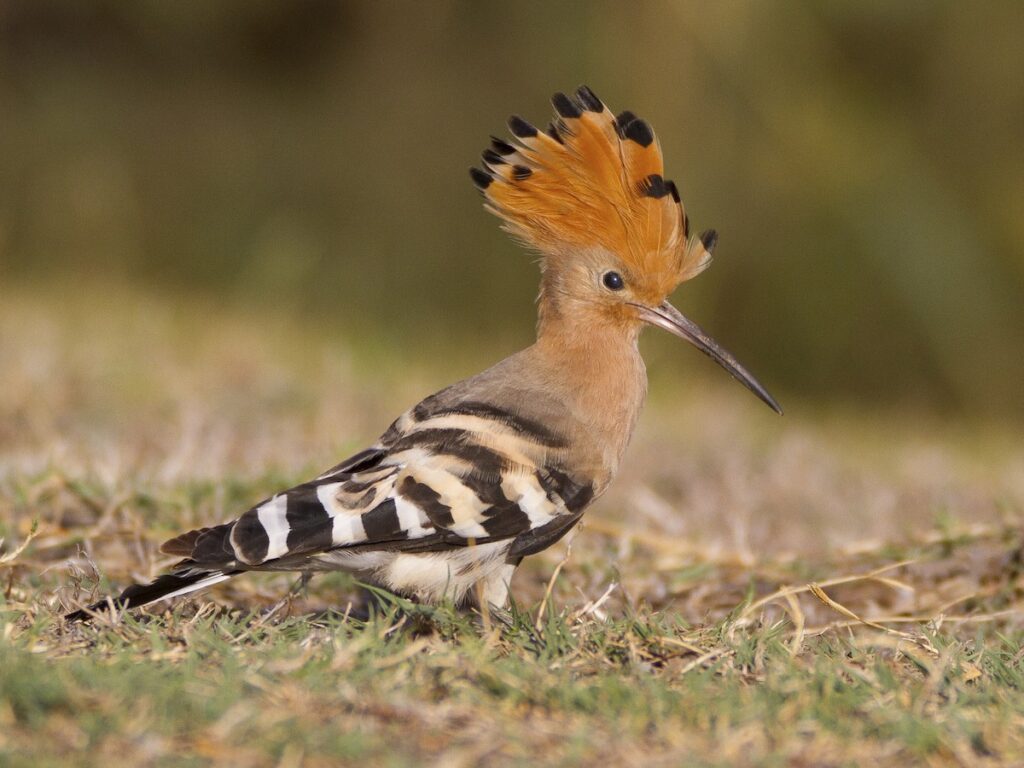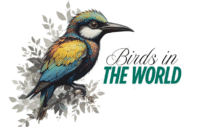The Hoopoe, a striking bird with a dramatic black-and-white striped crest, peachy plumage, and slender, curved beak, graces Lisbon’s urban gardens and parks with its distinctive “hoop-hoop” calls and elegant foraging. Found in green spaces like Jardim da Estrela and Monsanto Forest Park, this feathered monarch captivates city dwellers with its unique beauty and historical allure. Despite urban challenges, the Hoopoe thrives, embodying Lisbon’s blend of nature and culture. This article explores the Hoopoe’s vibrant appearance, urban adaptations, ecological role, cultural significance, and conservation needs, celebrating its status as a cherished urban icon.

The Exuberant Charm of the Feathered Hoopoe
A Crowned Spectacle in the City
The Hoopoe is a visual delight, its erectile crest of black-tipped feathers resembling a crown, paired with warm peach-colored plumage and bold black-and-white wings. Its long, curved beak adds elegance to its silhouette, especially when raised in display. For example, its crest flares dramatically during courtship, enchanting onlookers in Lisbon’s gardens. This crested jewel’s radiant hues make it a standout in urban green spaces, a living artwork in Portugal’s capital.
Lisbon’s Urban Garden Sanctuaries
The Hoopoe favors Lisbon’s lush parks, botanical gardens, and suburban lawns, where it probes the soil for insects in places like Jardim Botânico and Belém’s green spaces. It adapts to urban environments by nesting in tree hollows and stone walls. However, habitat loss from urban development threatens these havens, as explored in our Urban Birds Worldwide category. The garden star’s presence in Lisbon underscores the importance of preserving urban greenery in Mediterranean climates.
Behavior and Ecology of the Urban Hoopoe
Distinctive Calls and Courtship Displays
The Hoopoe is known for its unmistakable “hoop-hoop” calls, a soft, rhythmic sound used to claim territory and attract mates in Lisbon’s urban landscapes. These vocalizations, often heard at dusk, pierce the city’s hum, signaling its presence. For instance, males bob their crests while calling, creating a captivating spectacle, as detailed in our Bird Songs and Calls category. The Hoopoe’s songs add a melodic charm to Lisbon’s urban soundscape.
Insect-Hunting Prowess and Ecological Balance
As an insectivore, the Hoopoe feeds primarily on beetles, crickets, and larvae, using its slender beak to probe lawns and soil in Lisbon’s parks. Its feeding controls pest populations, supporting urban garden health. As a result, it plays a vital ecological role, though pesticide use threatens its food supply. The feathered monarch’s foraging ties it closely to Lisbon’s urban ecosystems, making it a key player in maintaining green space vitality.
Cultural Significance of the Crested Hoopoe
A Symbol in European Folklore
The Hoopoe holds a rich cultural legacy in Europe, revered in Portuguese folklore as a symbol of wisdom and renewal, often depicted in medieval manuscripts and fables. Its distinctive crest inspired tales of royalty and mysticism, as seen in historical narratives across the continent. This significance aligns with other iconic species in our Historical Birds category, where birds shape cultural stories. The garden star’s presence in Lisbon’s heritage enriches the city’s historical tapestry.
A Draw for Urban Ecotourism
The Hoopoe enhances Lisbon’s ecotourism appeal, drawing birdwatchers to urban sites like Parque Florestal de Monsanto and the Tagus Estuary. Its crest displays and rhythmic calls feature in guided tours, boosting local economies. Moreover, its elusive nature adds intrigue to city nature trails, blending wildlife with cultural exploration. The crested jewel’s charisma fuels efforts to promote Lisbon as a biodiversity hub, captivating global visitors.
Ecological Role of the Vibrant Hoopoe
Supporting Urban Green Spaces
The Hoopoe contributes to Lisbon’s urban ecosystems by controlling insect populations, reducing the need for chemical pesticides in parks and gardens. Its foraging supports plant health, benefiting other urban wildlife like butterflies and sparrows.
Interactions with Urban Wildlife
In Lisbon’s green spaces, the Hoopoe competes with starlings and blackbirds for insects, using its calls to defend foraging patches. Its vibrant crest attracts attention from urban predators like cats, requiring cautious behavior. For instance, its low foraging posture minimizes detection, ensuring survival. These interactions reveal the Hoopoe’s dynamic place in Lisbon’s urban wildlife, a shimmering thread in the city’s ecological fabric.
Conservation Challenges for the Garden Hoopoe
Threats from Urbanization and Pesticides
The Hoopoe faces challenges from urban expansion, which reduces nesting sites and green spaces in Lisbon’s suburbs. Pesticide use in parks depletes its insect prey, impacting food availability. As noted by SPEA, habitat degradation threatens many European bird species. Protecting urban gardens and reducing chemical use is essential to ensure the Hoopoe continues to grace Lisbon’s skies with its crested splendor.
Community Conservation Initiatives
Lisbon’s residents are rallying to protect the Hoopoe through initiatives like urban park restoration and pesticide-free gardening campaigns. Community groups monitor nesting sites in botanical gardens, minimizing disturbances. Furthermore, ecotourism programs educate visitors about the feathered monarch’s plight, fostering support.
Why the Hoopoe Enchants Lisbon
The Hoopoe, with its flamboyant crest, rhythmic calls, and vital ecological role, embodies Lisbon’s vibrant fusion of urban life and natural beauty. Its cultural resonance, ecotourism appeal, and conservation story make it a cherished city icon, yet its survival hinges on protecting urban green spaces. From medieval fables to modern parks, this bird weaves a colorful narrative through Lisbon’s identity. In conclusion, the Hoopoe inspires us to nurture urban ecosystems, ensuring its crested brilliance endures. Have you seen the Hoopoe’s crest in a Lisbon garden or heard its calls? Share your story in the comments and join our community of bird lovers!
